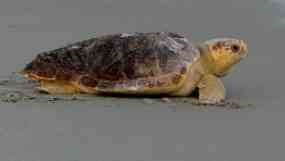
NPS Common Name: Loggerhead-named for its very large head. Scientific Name: Caretta caretta Description: Loggerheads are the most common species of sea turtle in the waters surrounding Cape Hatteras. They are also the Seashore’s most common nesting turtle. Head is very large with heavy strong jaws. Reddish brown coloration on head, flippers, and top-part of shell. Yellowish-brown to white coloration on lower-part of shell. Front flippers are short and thick with 2 claws and the rear flippers can have 2 or 3 claws. Hatchling/young coloration ranges from dark brown to light brown above and whitish to yellowish below. Size: Diet: Loggerheads are omnivorous (consume both plants and animals). Invertebrates seem to be the most important food source, and the loggerhead’s large head and massive jaws are well adapted for crushing hard-shelled prey. Prey consumed includes: sponges, jellyfish, marine worms, squid, conchs, whelks, various species of bivalves, shrimp, various species of crab, sea urchins, various species of starfish, and various species of algae and sea grass. Habitat: The loggerhead wanders widely throughout its range. It enters bays, lagoons, salt marshes and creeks, and the mouths of large rivers. Hatchlings and juveniles seek shelter and food in floating mats of Sargassum (a type of seaweed). Nesting: Nest at intervals of 2, 3, or more years. They can lay 1 to 7 nests per season, approximately 11-15 days apart. Each nest laid can contain between 50-130 eggs. Eggs have an incubation period of 49-76 days. The Cape Hatteras National Seashore is near the edge of the northern limit of their nesting range. Range: Found in all temperate and tropical waters throughout the world. The loggerhead turtle nests farther from the tropics than any other marine turtle! Status: Population Estimate: around 44,560 nesting females (male population numbers are unknown). |
Last updated: August 30, 2023
